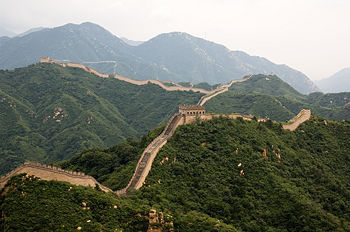Great Wall of China: Difference between revisions
imported>Eddie Ortiz Nieves (created new draft page for a Core Article) |
imported>Eddie Ortiz Nieves (added Image:Great Wall of China.jpg) |
||
| Line 1: | Line 1: | ||
{{subpages}} | {{subpages}} | ||
[[Image:Great Wall of China.jpg|right|thumb|350px|{{#ifexist:Template:Great Wall of China.jpg/credit| | |||
{{Great Wall of China.jpg/credit}}<br/>|}}A section of the Great Wall.]] | |||
The '''Great Wall of China''' ([[Pinyin]]: ''Wànlǐ Chángchéng''; literally "The long wall of 10,000 Li") is a series of stone and earthen fortifications in [[China]]. They were built between the 5th century BC and the 16th century AD to protect the northern borders of the [[Chinese Empire]]. It starts at Shanhaiguan in the east and ends at Lop Nur in the west. <ref>http://www.britannica.com/eb/article-9037891/Great-Wall-of-China</ref> Stretching over approximately 4,500 miles, it is the world's longest human-made structure, can be seen from [[space]] with the naked eye, <ref>http://news.bbc.co.uk/2/hi/asia-pacific/4459311.stm</ref> and is one of the largest building-construction projects ever carried out. <ref>http://www.american.edu/ted/ice/wall.htm</ref> It is also one of the New Seven Wonders of the World <ref>http://www.msnbc.msn.com/id/19652635/</ref> and a UNESCO World Heritage Site. <ref>http://whc.unesco.org/en/list/438</ref> | The '''Great Wall of China''' ([[Pinyin]]: ''Wànlǐ Chángchéng''; literally "The long wall of 10,000 Li") is a series of stone and earthen fortifications in [[China]]. They were built between the 5th century BC and the 16th century AD to protect the northern borders of the [[Chinese Empire]]. It starts at Shanhaiguan in the east and ends at Lop Nur in the west. <ref>http://www.britannica.com/eb/article-9037891/Great-Wall-of-China</ref> Stretching over approximately 4,500 miles, it is the world's longest human-made structure, can be seen from [[space]] with the naked eye, <ref>http://news.bbc.co.uk/2/hi/asia-pacific/4459311.stm</ref> and is one of the largest building-construction projects ever carried out. <ref>http://www.american.edu/ted/ice/wall.htm</ref> It is also one of the New Seven Wonders of the World <ref>http://www.msnbc.msn.com/id/19652635/</ref> and a UNESCO World Heritage Site. <ref>http://whc.unesco.org/en/list/438</ref> | ||
Revision as of 15:12, 28 October 2007
The Great Wall of China (Pinyin: Wànlǐ Chángchéng; literally "The long wall of 10,000 Li") is a series of stone and earthen fortifications in China. They were built between the 5th century BC and the 16th century AD to protect the northern borders of the Chinese Empire. It starts at Shanhaiguan in the east and ends at Lop Nur in the west. [1] Stretching over approximately 4,500 miles, it is the world's longest human-made structure, can be seen from space with the naked eye, [2] and is one of the largest building-construction projects ever carried out. [3] It is also one of the New Seven Wonders of the World [4] and a UNESCO World Heritage Site. [5]
History
The wall's construction began during the Warring States Period, which lasted from 403 to 221 BC. Qin Shi Huang, establisher and first emperor of the Chin dynasty, erected the largest portion of the wall as a defense against attacks by nomadic peoples. Real work on the wall began on 221 BC, after Shi Huang had united China under his rule, and it was finished on 204 BC. Small sections of the wall already existed, but Huang had nearly 1,200 miles of the wall built during his reign. More than 300,000 men worked connecting the segments into a single, huge wall of stone and earth. During the Ming Dynasty of 1368 to 1644 AD, interest in the Great Wall was revived, and it was repaired and extended, this time reinforced with cement and stone. [6]
References
- ↑ http://www.britannica.com/eb/article-9037891/Great-Wall-of-China
- ↑ http://news.bbc.co.uk/2/hi/asia-pacific/4459311.stm
- ↑ http://www.american.edu/ted/ice/wall.htm
- ↑ http://www.msnbc.msn.com/id/19652635/
- ↑ http://whc.unesco.org/en/list/438
- ↑ http://www.paulnoll.com/China/Tourism/history-Great-Wall-1-beginning.html
